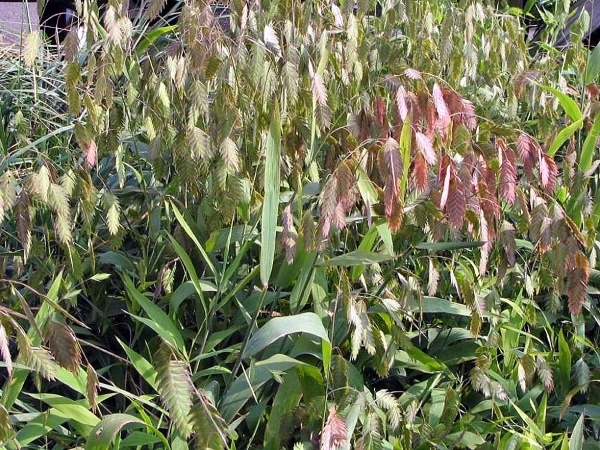
Northern Sea Oats
Botanical Name
:
Chasmanthium latifolium
Plant Type
:
Warm season perennial ornamental grass
Seasons
:
Grows in spring and summer, flowers in late summer
Sun Level
:
Prefers partial to full shade, ideally in 4-6 hours of sunlight
Ideal Soil Temperature for Planting
:
55–65°F (13–18°C)
Soil Type
:
Prefers moist, well-drained soil; tolerates clay and sandy soils
Hardiness Zones
:
5–8 (USDA)
Germination
:
14–21 days. Seeds need exposure to 30-60 days of cold before they will germinate
P.H. Level
:
6.0 to 7.0 (slightly acidic to neutral)
Water/Irrigation
:
Water consistently for new plants, then switch to deeper, less frequent watering. Once established, it is drought-tolerant
Fertilization
:
Light application of balanced fertilizer or compost in early spring if soil is poor
Habit
:
Clump-forming, arching grass with bamboo-like leaves and dangling seed heads
Propagation
:
By seed (fall sowing recommended) or division in early spring
Final Plant Height
:
24–48 inches
Spread
:
12–36 inches
Spacing
:
18–24 inches apart
Flowers
:
Flat, drooping seed heads that resemble oats; green in summer, turning bronze in fall
Attracts
:
Birds (for seeds), butterflies, and other pollinators
Uses
:
Ornamental landscaping, erosion control, rain gardens, dried flower arrangements
Companions
:
Black-eyed Susan, Joe Pye Weed, Coneflowers, Little Bluestem
Pruning
:
Cut back old foliage in early spring before new growth appears. Although not essential, light prune container plants to remove broken branches for aesthetics
Toxicity
:
Non-toxic to humans and pets
Pests
:
Rarely affected by pests but may attract grasshoppers
Diseases
:
Generally disease-resistant but may develop leaf spots in overly wet conditions
Expert Care Tips
:
Northern Sea Oats spread aggressively by self-seeding, so deadhead seed heads if you want to control its spread
Botanical Name
:
Chasmanthium latifolium
Plant Type
:
Warm season perennial ornamental grass
Seasons
:
Grows in spring and summer, flowers in late summer
Sun Level
:
Prefers partial to full shade, ideally in 4-6 hours of sunlight
Ideal Soil Temperature for Planting
:
55–65°F (13–18°C)
Soil Type
:
Prefers moist, well-drained soil; tolerates clay and sandy soils
Hardiness Zones
:
5–8 (USDA)
Germination
:
14–21 days. Seeds need exposure to 30-60 days of cold before they will germinate
P.H. Level
:
6.0 to 7.0 (slightly acidic to neutral)
Water/Irrigation
:
Water consistently for new plants, then switch to deeper, less frequent watering. Once established, it is drought-tolerant
Fertilization
:
Light application of balanced fertilizer or compost in early spring if soil is poor
Habit
:
Clump-forming, arching grass with bamboo-like leaves and dangling seed heads
Propagation
:
By seed (fall sowing recommended) or division in early spring
Final Plant Height
:
24–48 inches
Spread
:
12–36 inches
Spacing
:
18–24 inches apart
Flowers
:
Flat, drooping seed heads that resemble oats; green in summer, turning bronze in fall
Attracts
:
Birds (for seeds), butterflies, and other pollinators
Uses
:
Ornamental landscaping, erosion control, rain gardens, dried flower arrangements
Companions
:
Black-eyed Susan, Joe Pye Weed, Coneflowers, Little Bluestem
Pruning
:
Cut back old foliage in early spring before new growth appears. Although not essential, light prune container plants to remove broken branches for aesthetics
Toxicity
:
Non-toxic to humans and pets
Pests
:
Rarely affected by pests but may attract grasshoppers
Diseases
:
Generally disease-resistant but may develop leaf spots in overly wet conditions
Expert Care Tips
:
Northern Sea Oats spread aggressively by self-seeding, so deadhead seed heads if you want to control its spread
Written by Salome Wapukha – https://www.linkedin.com/in/salome-wapukha-556700193/

